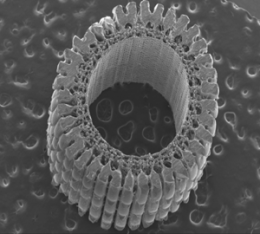Sea urchin's spiny, elastic strength revealed

(Phys.org)—For the first time, a team of Australian engineers has modelled the microscopic mechanics of a sea urchin's spine, gaining insight into how these unusual creatures withstand impacts in their aquatic environment.
The skeleton of the purple-spined sea urchin (Centrostephanus rodgersii), found in tidal waters along the coast of New South Wales, has many long spines extending from its core. These spiky features are used for walking, sensing their environment, and for protection against predators and rough surf.
The long hollow spines are made from a single crystal of calcite – which is essentially glass – arranged in a porous, intricate structure. Material scientists are interested in the chemical composition of these spines, but there has been no exploration of how they respond to mechanical stress.
In this latest study, published in the open-access journal PLOS ONE, researchers from UNSW and the Australian National University explain how this unique and intricate structure enables an advantageous blend of elasticity and brittleness, which allows the spine to better absorb impacts and stress under some conditions, and snap off under others.
In addition to offering some new insight into this curious marine animal, researchers say the finding could offer clues for creating new bio-inspired materials and more efficient engineering designs, which often strive to improve strength-to-weight efficiency.
The sea urchin's spine strength is particularly interesting given the brittleness of its constituent materials, says lead author Dr Naomi Tsafnat from the School of Mechanical and Manufacturing Engineering at UNSW.
"While we're not certain that this evolutionary feature is optimised, it certainly works – the longevity of this creature, having survived hundreds of millions of years, is a testament to that," she says. "The spine is both strong and lightweight, and has mechanical characteristics that suit the sea urchin's needs."
"It can withstand some types of loads, like compression, which allows the sea urchin to manoeuver and walk around, but snaps easily when the urchin needs to protect itself from predators."
Using a process known as microtomography, the researchers created a high-resolution 3D microscopic image of a segment of spine, which allowed them to identify unique features in its architecture. These included protruding wedges and barbs on their surface, linked together by tiny bridging structures that spiral around the spine's axis.
The team used this 3D image to create a computer model of the spine segment, and then simulated various mechanical load scenarios. They observed that different types of stress concentrate at different points within the architecture. This contributes greatly to its strength and unusual elasticity under certain strains.
Journal information: PLoS ONE
Provided by University of New South Wales




















